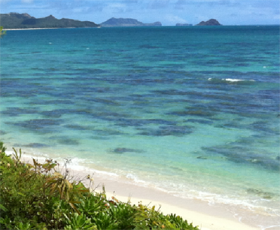 Have you ever wondered how or why asphalt pavement degrades? Here in Hawaii, we do not have harsh winters that cause freeze-thaw damage where water damages pavement by switching between solid and liquid states. But other harmful elements such as UV radiation and rainfall are prevalent in the islands. While it is assumed that asphalt pavements will last twenty years or more, the truth is that Hawaii’s environment can accelerate the rate of pavement failure.
Have you ever wondered how or why asphalt pavement degrades? Here in Hawaii, we do not have harsh winters that cause freeze-thaw damage where water damages pavement by switching between solid and liquid states. But other harmful elements such as UV radiation and rainfall are prevalent in the islands. While it is assumed that asphalt pavements will last twenty years or more, the truth is that Hawaii’s environment can accelerate the rate of pavement failure.
Oxidation is the main reason why pavements fail. Your pavement is made of up of a gravel and sand aggregate, and it’s “glued” together by an asphalt binder. Exposure to oxygen will eventually cause the asphalt binder to lose its glue-like properties and become brittle. This leads to cracks in your pavement and raveling, as there’s nothing to hold the rocks and sand together.
Hawaii’s Sun and Rain
 UV radiation also contributes to pavement deterioration by making the asphalt binder brittle. While most of us love the Hawaii sun, it’s bad news for pavements. Hawaii is constantly exposed to high levels of UV radiation. You can take a look for yourself and use the EPA UV Index for your area.
UV radiation also contributes to pavement deterioration by making the asphalt binder brittle. While most of us love the Hawaii sun, it’s bad news for pavements. Hawaii is constantly exposed to high levels of UV radiation. You can take a look for yourself and use the EPA UV Index for your area.
While Hawaii is known for its sun, during our “winter” season, we get a lot of rain. In fact, according to NOAA National Climatic Data Center, the state of Hawaii receives 63.7 inches of rain a year, the highest state-wide average of annual rainfall in the United States! What this means for your pavement is increased exposure to moisture. If your binder has become brittle and cracks have formed in your pavement, water and rain can seep into it and erode the base course. This leads to the base course flexing, causing even more cracks for water and rain to enter.
What To Do About The Environment
For all the fun we have in the sun, pavements suffer if not protected. Just as we protect ourselves from UV radiation with sunscreen, we can protect our pavement by sealcoating. Sealcoating provides a “coat,” that like sunscreen for our skin, blocks UV rays from damaging the pavement and asphalt binder.
 During the rainy season, most of us will stay indoors. The same idea can be applied to your pavement. A sealcoat acts as a “roof” for your pavement, protecting the asphalt binder and base course from moisture.
During the rainy season, most of us will stay indoors. The same idea can be applied to your pavement. A sealcoat acts as a “roof” for your pavement, protecting the asphalt binder and base course from moisture.
Sealcoating is a great strategy in protecting and maintaining your parking lot pavement from Hawaii’s environment. Not only that, it returns your pavement’s color to rich black (while oxidized pavement is gray) which is aesthetically pleasing.
Now you know why Hawaii’s environment is damaging to pavements. But if you take a proactive approach with pavement maintenance, you can protect your pavement while still enjoying Hawaii’s awesome weather for yourself!
